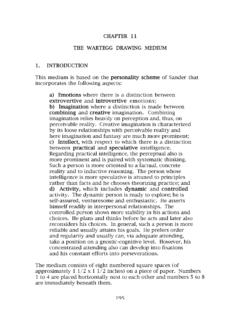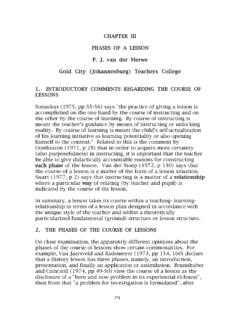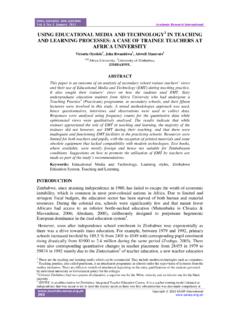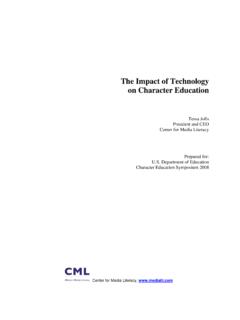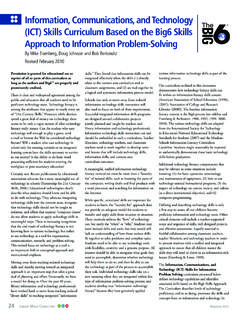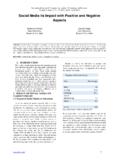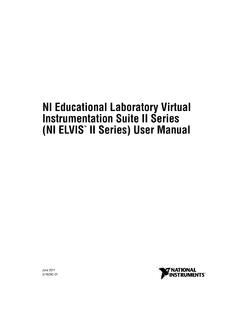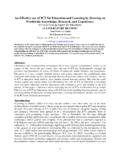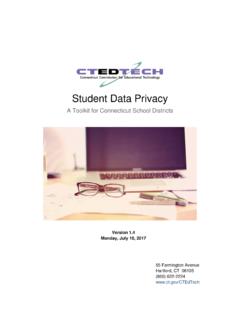Transcription of CHAPTER VII TEACHING AND LEARNING AIDS IN …
1 66 CHAPTER VIITEACHING AND LEARNING aids IN THE LESSON STRUCTUREP. J. van ZylRand Afrikaans University1. INTRODUCTIONWhen there is talk of TEACHING and LEARNING aids in the lessonsituation, by no means is there an attempt to plead for their use inteaching. At this stage of TEACHING , we (ought to) have alreadyadvanced far enough so that it no longer is necessary to make a casefor the use of media. Research has shown that if used appropriatelyand in the right place, they contribute to purposeful TEACHING . A fewrelevant terms are considered Audiovisual aids *Certainly the best-known and most used term is "audiovisual aid".
2 This amounts to the teacher or docent using a number of aids to tryto improve his TEACHING . These aids are directed particularly at theauditory and/or visual senses (separately or together). This isrepresented as follows:Figure 1: The use of audiovisual aidsTeacher/docent Pupil/studentAudiovisual aids (Hinst, 1971, p 43).Various authorities agree that this approach is one-sidedly attunedto apparatuses without considering whether they make a real * Based on Van Zyl, P. J. (1977). Onderwystegnologie in universitereverband.
3 Publication Series of the Rand AfrikaansUniversity, No. to improving TEACHING (Hinst, 1971, p 39; Sekerak andMcDonald, 1969, p 47; Grayson, 1976, p 121). Janssen (1969,p 54) even talks of "gadgeteers" when referring to advocates of thisapproach. Hinst (1971, p 39) summarizes this as follows: "The'gadget' approach of the last 20 years, which was confined topropagating the technical possibilities of media, catering to aminimum of software, in the last analysis, has failed."Various reasons can be offered as to why this approach has notmade much of a contribution to renewing and improving most important certainly are the following:1.
4 The excessive emphasis on apparatus has restrained themeaningful development of programming (Among others seeOettinger, 1969, pp 157-158).2. The great stress on apparatus has lead to a continual swing of thependulum from the use of a particular apparatus ( , 16 mmmoving picture projector) to what has followed ( , television).Each new apparatus developed is then presented as the best aid (Seeamong others Sekerak and McDonald, 1969, p 47).3. The mentioned emphasis on apparatus evoked a negativereaction from very right-thinking teachers and docents because a lotof money was spent on apparatuses that went unused.
5 This negativereaction was stimulated further because proper provision was notmade for planning and producing Little resulted directly from a really meaningful integration ofmedia into Research on the use of aids in TEACHING continually resulted in nodifferences between TEACHING with and without aids (Among others,see Campeau, 1974, p 31; Solomon, 1976, p 25).An analysis of the situation in South Africa indicates that we are stilllargely in the stage of using audio-visual aids . A first breakthroughto something more than audio-visual aids began to be noticed (Seeamong others Conradie, 1977; Meyer, 1974; Strydom, 1976).
6 Theground breaker of this development was certainly the South AfricanArmy's College of Educational TEACHING aids68 Van der Stoep et al. (1973, pp 130-131) use the term " TEACHING aid"to summarize instructional and LEARNING aids . Instructional aids arewhat the teacher uses in presenting a lesson while LEARNING aids areused by the pupils. This is a very fine distinction and it oftenhappens that in one period the same TEACHING aid can be used bothas an instructional and a LEARNING aid ( , a chalkboard). Media*There is a wide diversity of standpoints about what is meant bymedia in TEACHING .
7 De Cecco (1968, p 527) represents the approachconcerning audio-visual aids that is in agreement with the abovepronouncements as follows: "The electro-mechanical devices whichact as middle conditions between the student and what he is tolearn." Here the emphasis is largely on and Ely (1971, p 282) define a medium as any person,material or event that creates circumstances that put the pupils in aposition to acquire knowledge, skills and dispositions. De Corte etal. (1974, p 189) go further and state that a medium is any meansused or presented by a teacher to function in the TEACHING situationin connection with reaching a particular TEACHING aim.
8 Thus, herethere is mention of an integration of the medium into TEACHING andin such a way that it is attuned to attaining particular the literature it is clear that the use of the term "media" hasconsequences for the use of the term "audio-visual aids " (See amongothers Hinst, 1971, p 43). However, some authors such as De Ceccostill use the term "media" as a synonym for "audio-visual aids " whileDe Corte et al., go much further. The views of the latter are entirelyacceptable because they mention programs and apparatuses that donot function only as aids but which are integrated into the term "media" and " TEACHING media" will be used in this chapterwith this TEACHING technology*As noted, the traditional approach to audio-visual aids has not led toa meaningful renewal of TEACHING .
9 However, it is possible that theproblem can be approached scientifically and thus can lead to asystematic integration of media into instruction. Teachingtechnology possibly offers a the late 1960's various overseas authors and commissionshave attempted to describe the use of TEACHING technologies (Amongothers see Bjerstedt, 1969 p 48; Chapman and Unwin, 1969 p 9; Ely,1972, p 36; Ericksson, 1969, pp 62-63; Filep, 1975, p 14; Gilbert,1969, p 57; Hawkins, Hitchens and Wallington, 1974, p 85; Hinst,1971, p 40; Oguri, 1969, p 36; Olson, 1974, p 78; Prigge, 1974, p 18;Silber, 1970, p 24).
10 Since it is not possible to make a completeanalysis of all of the different approaches to TEACHING technologieswithin the space of this CHAPTER only a few influential works will a point of departure, Janssen's (1969, p 56) view of Teachingtechnology will be closely looked at. He defines Teachingtechnology as technical-scientific applications to TEACHING with aview to the aim and structure of TEACHING . This application arisesthrough the mutual attunement of the scientific rules andconclusions about TEACHING (the didactic)

